You’d think that art is art, but who’s going to which gallery on First Fridays is instructive. At Snyderman, and the Works, its middle-aged, well-heeled people who can afford to buy. At Wexler, it’s also well-heeled but the age skews a little younger. And at the Painted Bride, it’s jeans, wild hair and artists (not all young), who look like their money has its limits.
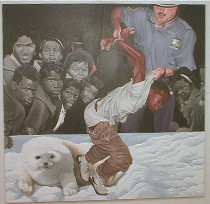 While the demographics sometimes indicate quality, sometimes they don’t. What they really indicate is degree of risk. I don’t mean whether the art itself is edgy or risky. I mean whether investing in the art is edgy or risky. Down at the Bride, there’s less certainty that this is stuff going somewhere.
While the demographics sometimes indicate quality, sometimes they don’t. What they really indicate is degree of risk. I don’t mean whether the art itself is edgy or risky. I mean whether investing in the art is edgy or risky. Down at the Bride, there’s less certainty that this is stuff going somewhere.
But there’s a good chance that it’s stirring up either society or art standards.
So it is with “Say Something: The Art of Politics,” an exhibit that opened First Friday at the Painted Bride, curated by Cavin Jones (shown above, his “To See Through Eyes That Only See What’s Real”) and In Liquid. In addition to raising some political issues, the show raises the same issues of quality that Robert Asman brought up in his Nov. 6 post.
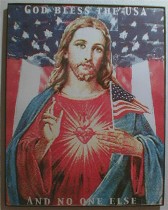 I find that when I agree with the political point of view, the clear message seems somewhat less offensive than when I don’t agree. Plus humor helps. So I got a kick out of Karen Fiorito’s image of Jesus, bleeding heart and all, with the legend, “God Bless the USA…and no one else” (shown). Though it’s funny, I doubt that George Bush would enjoy this print.
I find that when I agree with the political point of view, the clear message seems somewhat less offensive than when I don’t agree. Plus humor helps. So I got a kick out of Karen Fiorito’s image of Jesus, bleeding heart and all, with the legend, “God Bless the USA…and no one else” (shown). Though it’s funny, I doubt that George Bush would enjoy this print.
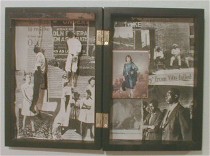 Nor am I sure what to think of Leroy Johnson’s powerful suite of 10 shadow boxes depicting the horror of lynchings and racial hatred, with newsclips of white and black America and images of men hanging off little 3-D wooden gibbets. I didn’t disagree with what I understood him to be saying, and the work had the power to startle me, repel me, and reconnect me to the brutality that we’d just as soon forget.
Nor am I sure what to think of Leroy Johnson’s powerful suite of 10 shadow boxes depicting the horror of lynchings and racial hatred, with newsclips of white and black America and images of men hanging off little 3-D wooden gibbets. I didn’t disagree with what I understood him to be saying, and the work had the power to startle me, repel me, and reconnect me to the brutality that we’d just as soon forget.
Johnson, whose clay work I much admire for its merger of poetry and anger (“Precendent” shown here), chose not to be poetic here. Does the passion carry the day or is this work too unambiguous? I’m interested to hear what others have to say.
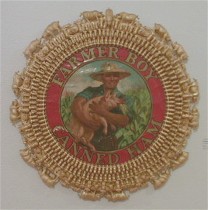 Adelaide Paul’s “Canned Ham,” with little gold pigs all around a goofy, found lithograph, is the American Dreamboat gone awry down on the farm with his corn-fed piggy. Again, the sense of humor leavens the message, and here the message is open to interpretation.
Adelaide Paul’s “Canned Ham,” with little gold pigs all around a goofy, found lithograph, is the American Dreamboat gone awry down on the farm with his corn-fed piggy. Again, the sense of humor leavens the message, and here the message is open to interpretation.
Paul’s “Vatican Dreams,” however, is heavy-handed, with the little sheep without genitals standing on a closed trunk, his kiddy-printed underpants at his feet. If I didn’t know about all the recent priest scandals, I could come up with other interpretations, but at this moment in time, those interpretations are irrelevant. My question is, can we wade into an issue with a clear right and wrong and still make art? And if the clear issue goes away over time, does the work become something better?
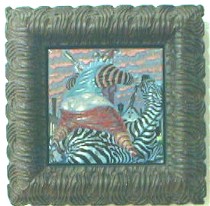
Don Colley’s “Different Stripes” (shown), however, was beautiful enough and ambiguous enough to avoid the political art pitfall of heavy-handedness. This one, with its striped zebra, striped clown, striped sky and striped frame I liked without reservation.









